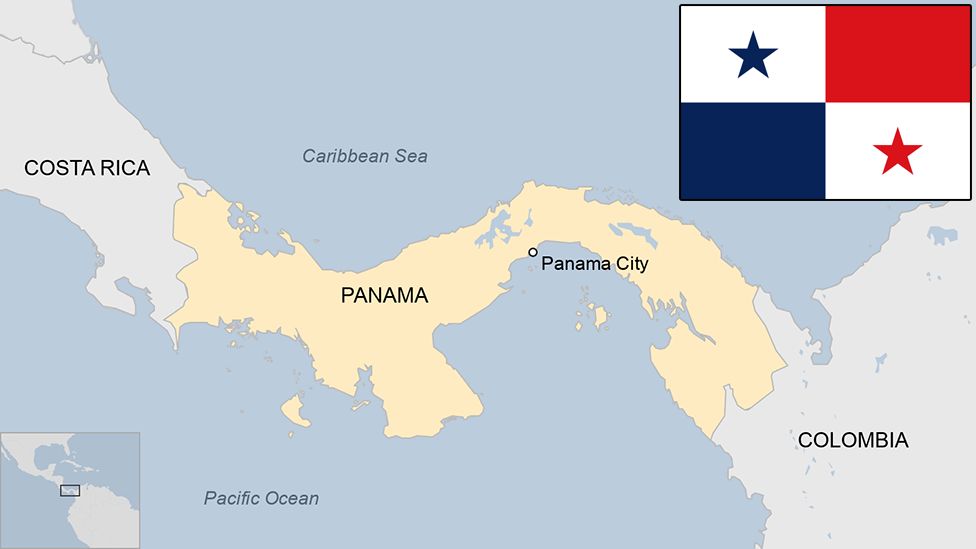Panama country profile
- Published

Lying at the crossroads of the North and South American continents and the Atlantic and Pacific oceans, Panama is of immense strategic importance.
This has made it the frequent object of US attention. The United States supported its secession from Colombia in 1903, and secured a sovereign zone in which to build the Panama Canal - which remained under US control from 1914 until 1999.
The US invaded in 1989 to depose a former ally, military ruler Manuel Noriega, over his repressive rule and use of the country as a centre for drug trafficking.
Panama has the largest rainforest in the Western Hemisphere outside the Amazon Basin.
However, it is for a feat of engineering, the canal connecting the Atlantic and Pacific oceans, that Panama is famous. Every year more than 15,000 vessels make the eight-hour journey through the waterway, which makes a substantial contribution to the economy.
- Read more country profiles - Profiles by BBC Monitoring
REPUBLIC OF PANAMA: FACTS
- Capital: Panama City
- Area: 75,417 sq km
- Population: 4.3 million
- Language: Spanish
- Life expectancy: 73 years (men) 80 years (women)
LEADERS
President: Laurentio Cortizo
A former head of the National Assembly, Mr Cortizo won the 2019 presidential election for the centre-left Democratic Revolutionary Party, narrowly beating Rómulo Roux of the conservative Democratic Change party.
MEDIA
Press freedom is protected by the constitution and journalists work in relatively safe conditions.
Most media outlets are privately owned. There are no restrictions on internet access.
TIMELINE
Some key dates in the history of Panama:
2500-1700 BC - Panama sees some of the first pottery-making in the Americas.
1502 - Spanish explorer Rodrigo de Bastidas visits Panama, which is home to Chibchan, Chocoan, and Cueva and other indigenous peoples.
Due to diseases such as smallpox, the indigenous population falls dramatically in the years following European settlement.
1513 - Following Vasco Núñez de Balboa's trek across the isthmus from the Atlantic to the Pacific, showing it is a bridge between the oceans.
1519 - Pedro Arias Dávila founds Panama City, which quickly becomes the marketplace of Spain's empire as gold and silver are brought by ship from South America up the Pacific coast, transported across the isthmus, and loaded aboard ships for Spain.
1671 - The privateer Henry Morgan, licensed by the English government, sacks and burns Panama city, then the second most important settlement in the Spanish New World.
1698 - Darien scheme, a failed attempt by Scotland to establish a colony in the region. The ensuing debt contributes to the union of England and Scotland in 1707.
1821 - Panama becomes independent of Spain, but joins the confederacy of Gran Colombia, which also comprises Colombia, Venezuela, Ecuador, Peru and Bolivia.
1831 - Panama becomes part of Colombia following the collapse of Gran Colombia.
1880s - France attempts to build a canal linking the Atlantic and Pacific oceans, but fails due to financial difficulties and the death of more than 20,000 workers from tropical diseases.
1903 - Panama splits from Colombia and becomes fully independent. US buys rights to build Panama Canal and is given control of the Canal Zone in perpetuity. The canal is completed in 1914.
1968 - National guard takes seizes power. The military bring in social reforms, expanding social security, education and carrying out land redistribution.
1981 - Leader Omar Torrijos dies in a plane crash. General Manuel Antonio Noriega subsequently takes over as Panama's leader.
1989 - US invades and ousts Gen Noriega.
1991 - Parliament approves constitutional reforms, including abolition of standing army.
1999 - Panama takes full control of the Panama Canal, ending nearly a century of US jurisdiction.
Related Topics
- Published15 January
- Published13 February
- Published31 March 2023
- Published4 April 2023
- Published31 March 2023
- Published14 February 2023